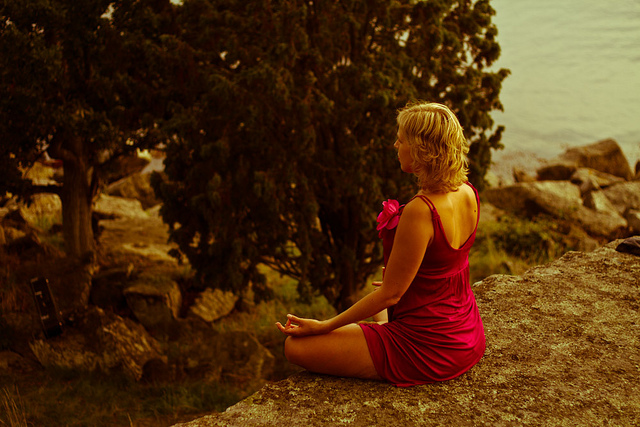I am often asked what it is about yoga that I love so much, why I get out of bed every morning before the sun comes up, walk up the hill, roll out my mat and practice the same set of postures day after day.
What is it about the fluidity of body, breath and mind that draws us all together each morning? Why practice?
I am still relatively new to yoga. I have been extremely blessed with amazing teachers both on and off the mat and was placed in a situation where I was able to delve deeply into the practice right from the start. I was incredibly fortunate to have started my practice in the mysore setting and was instantly blown away by the depth and beauty of the ashtanga vinyasa system.
Over the course of a few months, yoga radically transformed my life and I was possessed with a voracious desire to learn everything I could about this crazy new world of practice and philosophy that I was now a part of. I suddenly had a context in which to explore my ideals and beliefs, putting my values and worldviews into practice and coming to understand the power of community and relationship.
Although the practice of asana (posture) alone can become problematic, starting with the body makes perfect sense in this day and age. Many of us have or are struggling with various forms of insecurity that we associate with and impose on our bodies.
We have become largely disconnected from our bodies, locked into an adversarial relationship in which we feel the need to control, dominate and perfect our bodies rather than respecting the wisdom contained within the kinesthetic experience and honoring the many things our bodies can teach us from moment to moment.
For most of my life I struggled with body image issues. Like most girls at some point over the course of their lives, my body was a source of anxiety, fear and frustration. Struggling with disordered eating and substance abuse, my body was the recipient of all of my self-loathing and self-destructive behaviors. My body was not the problem; however, I did not have the tools to engage with how I was feeling and could not see where these knots of hurt and anger were coming from. Instead, I lashed out at my body, trying to kill any part of myself that I could.
When I began to practice, I suddenly had a very visceral medium with which to explore the roots of some of that hurt and began to discover a whole new depth of feeling and knowing within the contours of my own body. When we can learn to listen to our bodies, we can open ourselves up to a whole new level of intuition, provided with constant feedback as to the effects of our thoughts and actions on our lived experience.
Living in harmony with our bodies becomes a huge part of the practice and becomes a natural expression of the realization of our interconnectedness with the world around us.
What we choose to consume and wear, the way we carry ourselves, how we converse with others, these are all expressions of how we view ourselves and our connection with the world. We need to be constantly aware of how our actions and choices either bring us closer together or only further divide us.
We have no hope of being truly aware of these connections when we are not even aware of our own bodies. Reconnecting with the most visceral and material aspects of ourselves is the first step in this process of critical and ethical practice.
Of course, yoga is a lifelong process, so we cannot expect to change everything overnight; however, there are many things we can begin to change in this very moment and choosing to completely ignore the way our individual actions are deeply implicated in the lives of others, both human and other-than-human, is irresponsible. Not only that, it is a deeply damaging form of violence.
Our practice will never be perfect and no matter how socially and environmentally conscious we think we are becoming, there will always be some aspect of our experience that we have not yet considered; however, this in itself is the reason for practice. Rather than becoming discouraged, the inevitability of failure should propel us to even greater action. Failure is one of the most beautiful human experiences. When embraced, failure results in a deep letting go of some previously held notion, a part of ourselves that no longer serves us but that we have been unwilling or unable to let go of.
When we let go of something that we have so intimately identified with for so long, we are left with a new sense of beautifully open space in which the possibilities are endless. We often react to this space with an intense fear that can cause us to cling even more tightly, which is why failure must become a central part of our practice. If we can approach failure with awareness and compassion, allowing ourselves to be with failure rather than simply reacting to it, we can allow the experience of failing to become something radical in itself, a beautifully transformative process that can open us up to our deepest and most protected hurts. I fail every single day on my mat. And every day, as I return to my mat, I am able to fail just a little a bit better.
The ashtanga vinyasa system practiced in the mysore setting is one of the most powerful processes I have been fortunate enough to be a part of. Returning to the same set of postures day in and day out and watching the progress and changes in your body, breath and mind as you move through practice is a wonderfully inspiring gift and completely changes your perception as to what is possible, instilling a remarkable sense of independence, confidence and discipline. There is always that one posture that you are absolutely dreading having to do, that one posture that is the bane of your existence. But, regardless, every day you roll out your mat, you breathe and you confront that place of dread until one day you find that you are suddenly in the posture and that it has transformed into something entirely different.
This practice teaches us not to turn away from our discomforts. In facing them head on, day after day, we are able to explore the ways in which we can move beyond our habits and narratives of attachment and aversion in order to connect with something deeper. Through the practice of all eight limbs, ashtanga yoga provides a physical, emotional, psychological, and spiritual practice that allows us to connect with the core of who we are, asking each of us to experientially explore the complexity and depth of seemingly simplistic notions such as nonviolence and truthfulness. It is only through practice that we begin to understand the nuances of these principles.
Yoga has placed me at the heart of community, surrounded by amazing practitioners, teachers, and students. The practice has begun a process of deep emotional and psychological healing that has forced me out of my shell in order to learn how to be truly intimate with the world around me. Yoga is working to open my heart, creating the space to explore what a true ethical practice might entail.
For me, yoga has been a process of softening the rigid boundaries
I have spent my entire life constructing between my ideas of myself and the reality of the present moment, allowing me to engage with things as they are rather than as I would like them to be.
Yoga is a process of dropping our self-constructed narratives to really be with ourselves and others, as we are in this moment, with all of our imperfections and limited perspectives.
I know that yoga works. I know this and I have only just begun to traverse this path. Yoga is relationship and it is both a gift and a responsibility.
It is a reason to get up every morning, placing our lives in the context of practice in order to create the space for acceptance and compassion. So take up practice. Roll out your mat, listen to your breath, and work to become still enough to hear the answers in your own heart.
A true revolution of consciousness can only come from a place of stillness.
Love elephant and want to go steady?
Sign up for our (curated) daily and weekly newsletters!
Apprentice Editor: Holly Horne/Editor: Catherine Monkman
Photo: andreasivarsson, Flickr












Read 2 comments and reply